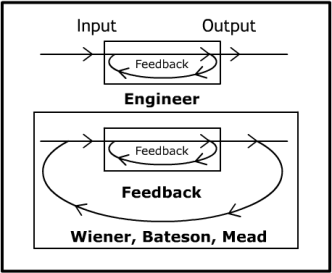Second-order cybernetics
Second-order cybernetics, also known as the cybernetics of cybernetics, investigates the construction of models of cybernetic systems. It investigates cybernetics with awareness that the investigators are part of the system, and of the importance of self-referentiality, self-organizing, the subject–object problem, etc. Investigators of a system can never see how it works by standing outside it because the investigators are always engaged cybernetically with the system being observed; that is, when investigators observe a system, they affect and are affected by it.
Overview

The anthropologists Gregory Bateson and Margaret Mead contrasted first and second-order cybernetics with this diagram in an interview in 1973.[1] It emphasizes the requirement for a possibly constructivist participant observer in the second order case:
- . . . essentially your ecosystem, your organism-plus-environment, is to be considered as a single circuit.[1]
Heinz von Foerster attributes the origin of second-order cybernetics to the attempts of classical cyberneticians to construct a model of the mind. Researchers realized that:
- . . . a brain is required to write a theory of a brain. From this follows that a theory of the brain, that has any aspirations for completeness, has to account for the writing of this theory. And even more fascinating, the writer of this theory has to account for her or himself. Translated into the domain of cybernetics; the cybernetician, by entering his own domain, has to account for his or her own activity. Cybernetics then becomes cybernetics of cybernetics, or second-order cybernetics.[2]
The work of Heinz von Foerster, Humberto Maturana, Gordon Pask, Ranulph Glanville, and Paul Pangaro is strongly associated with second-order cybernetics. Pask[3] recommended the term New Cybernetics in his last paper which emphasises all observers are participant observers that interact.
See also
- Gyroteleostasis
- Meta-
References
- ↑ 1.0 1.1 Interview with Gregory Bateson and Margaret Mead, CoEvolution Quarterly, June 1973.
- ↑ Von Foerster 2003, p.289.
- ↑ Pask, 1996.
Further reading
- Heinz von Foerster (1974), Cybernetics of Cybernetics, Urbana Illinois: University of Illinois.OCLC 245683481
- Heinz von Foerster (1981), 'Observing Systems", Intersystems Publications, Seaside, CA. OCLC 263576422
- Heinz von Foerster (2003), Understanding Understanding: Essays on Cybernetics and Cognition, New York : Springer-Verlag. ISBN 978-0-387-95392-2
- Humberto Maturana and Francisco Varela (1988). "The Tree of Knowledge", Shambhala, Boston and London.
- Humberto Maturana and Bernhard Poerksen (2004), "From Being to Doing". Carl-Auer Verlag, Heidelberg.
- Gordon Pask (1996). Heinz von Foerster's Self-Organisation, the Progenitor of Conversation and Interaction Theories, Systems Research 13, 3, pp. 349–362
- Scott, B. (2001). Conversation Theory: a Dialogic, Constructivist Approach to Educational Technology, Cybernetics and Human Knowing, 8, 4, pp. 25–46.
- William Irwin Thompson (ed.), (1987), 'Gaia - a way of knowing". Lindisfarne Press, New York.
- Francisco Varela (1991), "The Embodied Mind", MIT Press, Cambridge, MA.
- Francisco Varela, (1999), "Ethical Know-How", Stanford University Press.
External links
- Principia Cybernetica
- Cybernetics and Second-Order Cybernetics
- New Order from Old: The Rise of Second-Order Cybernetics and Implications for Machine Intelligence
- Constructivist Foundations, a peer-reviewed electronic journal dedicated to constructivism, second-order cybernetics, and related disciplines.
- Heinz von Foerester's Self Organization
- Cybernetic Orders